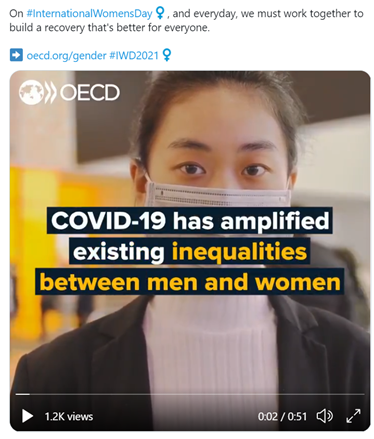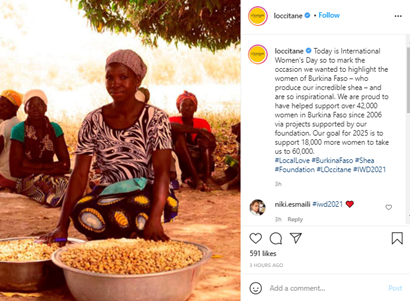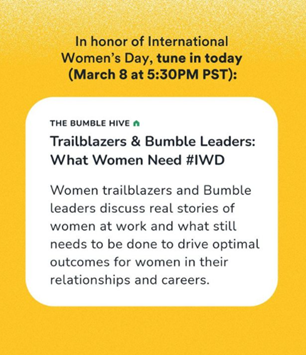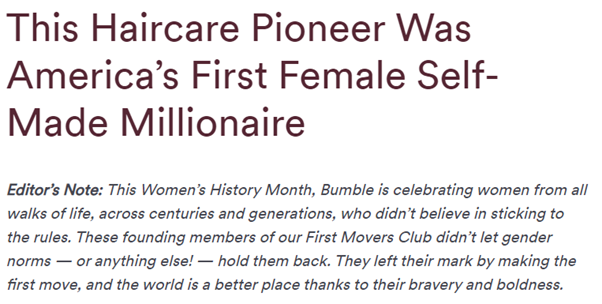It’s Women’s History Month. This annual month celebrates the achievements of women everywhere and raises awareness about gender inequality. Reflecting on how far women have come while acknowledging areas that still need to be improved is vital in helping to close pay gaps and support female-led initiatives. As the Creative Director of Contentworks, a women led content marketing agency, this is something I can relate to. I’m taking a closer look at why women’s month is important. Also what’s cool behaviour and what isn’t by the big brands. Let’s review the best of women’s month marketing in 2021.

Why Should We Care About Women’s History Month?
It’s easy to dismiss Women’s Day and Women’s History Month as a fad or just another commercial stunt. But if you think the world is fair for women. It’s not. ‘Choose to Challenge’ is this month’s mantra which recognises the need to call out gender bias and inequality. And the stats around this topics really do speak for themselves.
- A study from Deloitte revealed that less than 30% of the UK’s fintech workforce is female with only 14% represented on fintech boards. This disparity perhaps stems from the historic lack of senior women leaders within the industry, meaning there are fewer female success stories women can turn to in search of inspiration.
- Female directors at the UK’s largest financial services firms are paid on average two-thirds less than their male counterparts. Average pay for female directors at financial services companies stands at 247,000, 66% lower than the average 722,300 paid to male directors, according to research by employment and partnership law firm Fox & Partners.
- Covid-19 has amplified existing inequalities between men and women. Women are most likely to work in sectors most hit by the pandemic. Indeed, women’s job losses due to Covid-19 are 1.8 times greater than men’s job losses.
- As 2/3 of the global healthcare workforce is female, women have been at the frontline of this pandemic while battling additional pressures at home such as remote working and supporting home learning. But home isn’t always a safe environment with domestic lockdown against women also spiking during periods of lockdown.

- Women are far more likely to experience sexual harassment in the workplace, whether they are in a position of power or not. A survey of almost 5,000 adults found that women were 3 times as likely to have personally experienced sexual harassment at work, at 22% compared to just 7% of men. This is staggering and an upsetting statistic, women should not be afraid that they will be harassed in any way whether they are at work or in day-to-day life. Sometimes incidents like these can escalate so much that the need for legal representation is essential. By speaking to professionals found online at websites like DhillonLaw.com or speaking to local law firms, women are able to find their voice and clamp down on this and hopefully help those who need to speak up in the future.
It’s clear that Women’s History Month and the initiatives and campaigns around it are very much needed. So what’s going on in the marketing world?
What’s Not Cool?
Let’s start with my pick of what isn’t cool on Women’s Day or Women’s History Month.
- Turning your logo pink (or purple- Linkedin). What are we, 6? I find the nauseating colour change to be at best lazy and at worst, an insulting confirmation of gender bias. You’re a woman so you will like pink things? Nope.
- Talking about equality when you have no women in management. Brands who make sweeping statements about equality when there are no women on their board of directors or in their senior management. Better to just keep quiet.
- Making misogynistic jokes (Burger King)– Ok it got attention and yes there was a bigger point. But is it really the right time to headline your women’s day efforts with a misogynistic comment? And then issue snarky mansplainy replies? The campaign, created by agency David Miami, was repurposed into a series of tweets via the @BurgerKingUK Twitter account, where the full context wasn’t quite as obvious. Given that Twitter makes it easy to share tweets but not necessarily threads with additional clarification, the brand’s U.K. tweet quickly drew attention and backlash around the globe. It’s a no from me BK. I’m past finding sexist jokes funny. Burger King U.K. has apologized for and deleted its International Women’s Day tweet.

#1 L’Occitane En Provence – Ongoing Support for Burkinabe Women
It’s one thing having fantastic products, it’s another recognising that these products are possible thanks to an incredible workforce of women. L’Occitane En Provence is this year celebrating their ongoing admiration and support for the women in Burkina Faso who produce the brand’s incredible shea.
In honour of International Women’s Day (8 March 2021), L’Occitane launched a new Solidarity Hand Cream of which 100% of the profits will be donated to finance NGO projects to promote women’s leadership in the land-locked West African country. In the United States, L’Occitane will also be donating to Black Women’s Heath Imperative, supporting black women’s health and empowerment programs in the nation.

Why this campaign works:
- It’s not a one off. L’Occitane’s connection with the women behind their products is ongoing and dates back to the 1980s, when founder Olivier Baussan visited the women of Burkina Faso and learned first-hand about shea butter, also known as ‘women gold.’ What started as a dozen women harvesting the shea nut, has evolved into a community of 15,000 women who produce 700 tonnes of shea butter annually, through a long-term and 100% fair-trade partnership.
- It gives credit where credit is due. Many of L’Occitane’s products wouldn’t exist without their extended team of Burkinabe women and therefore recognition is important.
- The campaign has a strong sense of purpose and a meaningful call to action.
Top tip for brands: Embrace storytelling. This might mean going behind the scenes of a particular product or documenting the history of your brand’s origins. Pull out details that are unique to your product such as the ‘women’s gold’ description mentioned above.
This year, L’Occitane UK has also put influential women from their own brand in the spotlight. From Warehouse workers to those in the Head Office, L’Occitane has fully embraced the meaning of respecting hard working women across the workforce.

Top tips for brands: For Women’s History Month and beyond, you can share the success of female staff via video clips, host a question and answer session with female leaders or get members of your team to rundown what they do on a daily basis for social media. You never know who your content will empower.
#2 Secret Deodorant – #SecretSuperheroMom
According to data analysed by the National Women’s Law Center, every single one of the 140,000 jobs lost in the United States in December 2020 belonged to a woman. Excuse me? This shocking statistic was a ‘breaking point’ for the leadership at Secret Deodorant leading to a partnership with YWCA to tell stories of the women weathering the economic fallout of the pandemic. As well as raising awareness of the issues impacting women through a docuseries called Secret Superhero Moms, the powerhouse duo has pledged $1 million to support more than 100,000 women and their families with childcare, workforce development and barrier reduction.

This campaign is effective as it:
- Has a unique branded hashtag that’s catchy and easy to follow on Instagram and Twitter
- Is timely, relevant and shows a brand with a very clear vision when it comes to corporate responsibility. This is important considering consumers are 4-6 times more likely to buy from, trust and champion companies with a strong Purpose according to a recent ground-breaking study.
- Embraces storytelling which helps bring about an emotional response from consumers. This in turn helps people to connect with a brand easier.
#3 Bumble – Leading by Example
Female-founded dating app Bumble is leading by example this Women’s History Month by hosting a series of high-profile interactive events. This included an International Women’s Day Clubhouse chat with women trailblazers and Bumble leaders about women at work and what still needs to be done for women to thrive in their relationships and careers. Women don’t want to stop their careers for a full and loving relationship, so knowing how to juggle that whilst still feeling feminine is essential, from splashing on some pheromones perfume to knowing how to manage a boardroom, each one has a place in a woman’s everyday life and there shouldn’t be a compromise.

Social media networks like Clubhouse facilitate audio-only, invite-only chats which allow users to listen to and join in discussions of interest. It’s a network which Bumble is now using to their full advantage to discuss female-related topics and push for greater equality. The company announced their Clubhouse initiatives via Instagram where they already have a following of 563K. Considering Bumble is a women-led brand that has an equitable gender representation within their C-suite with 54% comprising of women, Women’s History Month is a great chance for some thought-provoking marketing.
Bumble also got tongues wagging with their First Movers Club initiative. This celebrates women from all walks of life across centuries and generations who didn’t believe in sticking to the rules. Bumble put the spotlight on women such as suffragette Alice Paul and America’s first black, female self-made millionaire Madame CJ Walker by creating a series of fact-driven articles. These were bang on trend with the Bumble brand and allowed the company to use content to their advantage without being overly promotional.

This article series is great because it:
- Pays respect to women who have carved a path for themselves amid a male dominated society. This is very much in-line with what female-led Bumble has done within the world of online dating.
- Taps into key challenges facing women around the world
- Presents an authentic female face to Bumble which is apt as the app is designed specifically for women.
#4 Boots – Estée Lauder Collaboration
From keeping work going during lockdowns to home schooling kids, women had a lot to navigate in the past year. To reward their hard work, Boots teamed up with Estée Lauder to host an Instagram competition. This encouraged followers to nominate a woman who they thought deserved to win 1000 of cosmetics. The instructions were to tag a woman, like the post and follow both Boots and Estée Lauder on Instagram. Pretty simple right? And a great example of brand collaboration.

This campaign was effective as it:
- Gave followers a reason to vote someone who has gone the extra mile this year.
- Boosted brand awareness for both brands and increased engagement on the channel and its posts
- Offered an awesome prize, which incentivised people to take part.
Top tip for brands: Know what you want to achieve from a marketing campaign by setting and monitoring key performance indicators (KPIs). For example, if the goal is to boost brand awareness, why not come up with a campaign that will increase Instagram follower numbers by XXX? You can then keep track of this to see how well you’ve done and to tweak where necessary for future marketing effort.
If you enjoyed this article, you may enjoy the two published by Contentworks Agency celebrating women in the finance sector. Check them out here:
Celebrating Women’s Day in the Finance Space
3 Awesome Women-Led Public Companies To Watch In 2021
What’s your favourite Women’s Month campaign or brand? Tweet me @Charli_Says and let me know.
PS – the cover image used shows suffrage and labor activist Flora Dodge “Fola” La Follette (1882-1970), social reformer and missionary Rose Livingston, and a young striker during a garment strike in New York City in 1913. https://www.loc.gov/resource/ggbain.12397/